
Part 2
MY TRIP TO MEXICO
AZTECS, BUTTERFLIES, EXHAUSTION
By Dixie Hughes, December, 2000
We finally arrived at Malinalco after skirting Tampico again and had another late lunch. The restaurant is two blocks down the steep hill from our bright blue hotel so we had to hike up and get checked in after lunch. We had the afternoon free to enjoy the "market day" on the main streets down by the church.

Some of us figured out how to use the cash machine and we looked for an Internet - no luck. The market was quite crowded but had many interesting booths. After climbing back up to the hotel, I decided to skip dinner and have a bit of R&R -- a hot shower and rest became more important than food.
On Thursday we began by walking the two blocks to the same restaurant for breakfast (it used to be Zapata’s hideout) and then walked to the Cultural Center to meet our guide for the Aztec temple.
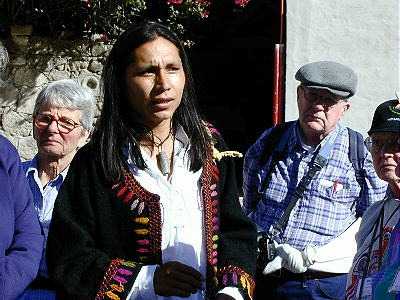
His name is Martin and he started by reciting a poem in Nauhatl (Aztec language); he’s definitely the Aztec nobility type - a shaman for his people. We walked first to the Barrio church for that area - there are eleven barrios in this area and the Spaniards built churches on top of the ancient temples that had been there before. When the natives came to worship at the churches they were actually following their ancient traditions because it was customary to build new temples on top of the old.
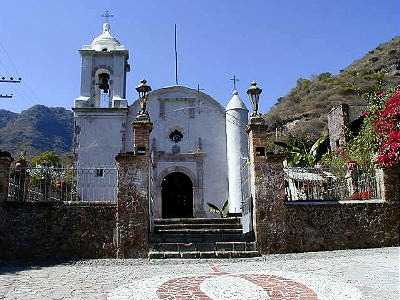

We then climbed the long path up to the Aztec temple above the town. It was a much easier path than we had climbed to see butterflies since they have paved and made low steps (supposedly 360 of them, but I didn’t count) all the way to the top, but it still took us awhile.


Martin stopped at several places along the way and blew his conch shell - it echoed back from the mountains around us. Too cool. He also showed us several of the medicinal plants along the way that have been used by the natives for centuries.
At the top Martin told us the history of the temple - a monolith - which means it was carved into the living rock and is the only monolith in North America. The only others are in India and Egypt and other Middle Eastern areas. This place functioned as the ceremonial center for the best Aztec warriors to become consecrated into the eagle or jaguar societies - the rulers/nobility of the Aztecs. The leaders were chosen based on valued characteristics and if they did well, they were given more service jobs until they were eventually promoted to become rulers of the country.Supposedly this area was where the original Mexhica or Tenochlica tribe arrived in their search for the "perfect place" to settle and the tribe split, with half of them staying here and the rest going on to Tenochtitlan to establish the Aztec capitol. They referred to themselves as Mechican. They picked this area because of the herb/grass grown in the area that spirals in on itself - and the spiral is a very sacred symbol to the Aztec. So this place was established as "sister of the sun" - the "moon group" stayed here and the sun group went on to the plateau where Mexico City is now.

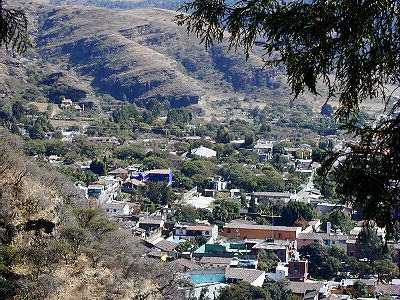
From the edge of the cliff we had a fantastic view of the town and our very blue hotel.

The temple atop the pyramid has 13 steps up to top room - 13 spheres of the cosmos in the Aztec world. So the temple at the top represents the axis of the universe. A warrior entering the serpent mouth (painted around entrance) was being reborn into a new life - blood was offered (body piercing) as "liquid jewel". From the top of the pyramid the cut in the eastern mountains is observable - the sun rises right on that cliff on Feb. 21 and Oct. 29 - which is 260 days and basis of the Aztec calendar.

Martin then performed a ceremony on the top of the pyramid - looking very Aztec - which involved blowing the conch shell in four directions. Quite impressive.
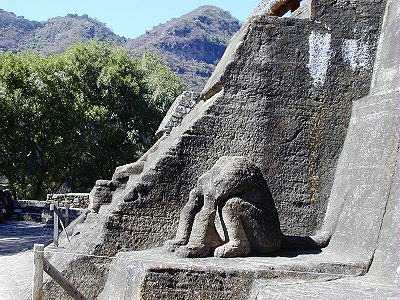

Then, of course, we had the hike back to the bottom - which was not as difficult but still quite tiring. It was nice to rest in the garden at the bottom, which had lots of different butterflies - it’s fun to be in a group where everyone is interested in the butterflies.



We had lunch at an outdoor restaurant, which also had more varieties of butterflies. We even saw White Morphos, which according to Paciano have become quite rare. Lovely.


After lunch we hiked back up a ways to see some caves that were used in many of the ancient ceremonies - but they were blocked off so we couldn’t really get to them. Then back around through town to see some of the other churches and past Martin’s house where his "sweat lodge" also has the painting of the Aztec serpent mouth.
Lots of "up and down" walking so we were glad to get back to the hotel to rest a bit before dinner. Cathy showed slides of the interior of the cathedral (called "Christ the King") that illustrated how the native workers incorporated their beliefs into the religious pictures/decorations they were forced to paint for the Spanish priests. (She also showed pictures of her "cave house" in Bisbee, Arizona. They blasted the cavity out of a granite cliff so many of her walls and ceilings are rock. Would be fun to see.)
The next day we left Malinalco after hiking down and up for breakfast again -- very unhandy without a restaurant in the hotel. Then we had to haul our luggage up to the bus -- I slept a lot when we finally got on. Paciano had forgotten to order our box lunches so we had to stop at a small village about 11 to wait for our lunches to catch up in a little pickup. Most of the group walked down to the river and back - I read my book on the bus.
We arrived in Taxco about 1:30 and got checked into a much nicer hotel (except our room had ants!) We did have a fantastic view of the city anyway. The afternoon was an optional tour around the city to see the churches but since I remembered them from my last trip to Taxco, I decided to enjoy the hotel facilities and local area. I even found an internet and lots of little shops to find presents for grandkids. Always fun. Other than fireworks with loud booms at 11 p.m. and again at 5 a.m., this was a much nicer stay - we even had a balcony.
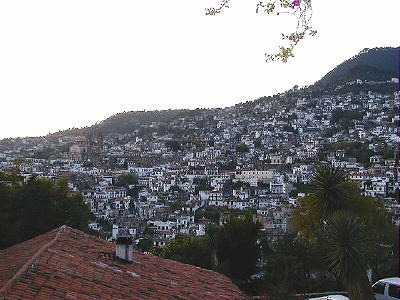
Up again and on the bus to Mexico City for our last night together. First we spent the afternoon at the Museum of Archeology which was something I had looked forward to since my last visit 30 years ago. I always said I could spend a week there, but since they had half of the areas closed for remodeling, I found the afternoon was long enough. They do have some fantastic Aztec artifacts though.

. The seal over the front entrance represents the Aztecs finding of an eagle eating a serpent which was the Aztec symbol of where to settle on Lake Tenochtichlan

The column in the center plaza of the museum is carved to represent historical events in Mexico. The wide top umbrella sometimes "rains" to wet anyone who happens to be standing around.

This jaguar greets visitors to the Aztec section of the museum. It was used to hold hearts of the sacrificial victims. Since the Aztecs/Mechicas/Tenochas (several names refer to the same people) didn’t come to the Mexico City area until 1325 they only had an impact for about 200 years before the Spaniards came and conquered them. The other six areas (three were closed) of the museum show some of the other native cultures of Mexico: Toltecs, Mayas, Oaxacans, etc.

It was not until 1978 while digging for the subway, that the Mexican people realized what archeological treasures were buried under their city. This is a model of what the ancient Aztec city looked like from what they have found so far. There is an intricate diorama of the city market scene in the museum hidden around behind the Sun Stone. The Spaniards purposely buried the entire city to build their own capitol here. The central pyramid is actually seven pyramids built one on top of the other - with two temples on the top to represent the duality of their religion (male/female, birth/death, sun/moon, blue/red, etc.)

The "Stone of the Sun" was discovered in 1790 and was thought to be a calendar because 20 signs of days are circled around the center. However, it is now thought to have been a sacrificial altar. It is a design of the face of Xiuhlecuhtle emerging from the center of the earth, holding a pair of human hearts and showing his tongue which is transformed into a sacrificial knife. He is surrounded by four suns that preceded a fifth sun inscribed in the sequence of 20 day signs framed with figure of the sun with four beams symmetrically accompanied by sacrificial sharp points. The star is surrounded by Xiuhcoatl or "Fire Serpents" which carry it across the heavens


The Aztec "Mother Goddess" was carved in volcanic stone and called "Coatlicue" or "Cihuacoatl" referring to her skirt of serpents and face made up of two serpent heads. There are 13 feathers carved into the back part representing levels of the cosmos. She must be 15 feet tall - very impressive.


Some of the Aztec carving is so detailed and intricate you wonder how it could have been done.


Our last group meeting was that evening after dinner - we sat in a circle and told what we had enjoyed/learned on the trip. Naturally we all were most impressed by the butterflies we had to climb so hard to see. (Ann said she learned to light a match in the bathroom; I said I learned a lot about Canadians. We did enjoy ourselves. )
Early the next morning, Ann & I got checked out, said goodbye to group members again and took a taxi to Hotel Cortez. This was my "extra" day - mainly because I fouled up my airline reservations and was going back a day later than the group activities were scheduled. It didn’t make much difference except I was suffering with a cold and not very good company. Ann was scheduled to stay in Mexico City for five more days so I went with her to her new hotel. We got checked in and decided to walk to the Zocolo (Mexico City’s main plaza) and see some of the sights. We enjoyed wandering through some huge buildings and the main cathedral, but the best part was finding the uncovered Aztec ruins and museum (which hadn’t been there last time I was in Mexico City). They have done a fantastic job opening up areas that they didn’t even know existed 30 years ago - and the museum is four floors of fascinating artifacts. We finally wore out and decided to have a snack and rest at the top of the hotel restaurant facing the plaza. That didn’t work out because you had to buy the whole buffet to sit up there and we weren’t that hungry - so we snacked at McDonalds down the street. Not as good a view but it worked.
When we finally walked all the way back to the hotel we both needed a nap before dinner. It’s a lovely old-fashioned hotel with the central open court (no longer open) used for dining. We had dinner and watched the folklore show - lots of energetic dancers in flashy costumes. It was a very pleasant "extra" day.
I was up early the next day to catch the flight to Dallas and then home. Sure was glad to get there with my stuffy head and tired body. This really was a "once in a lifetime" experience - I don’t think I’d try it twice.
Return to Dixie's Tour Menu